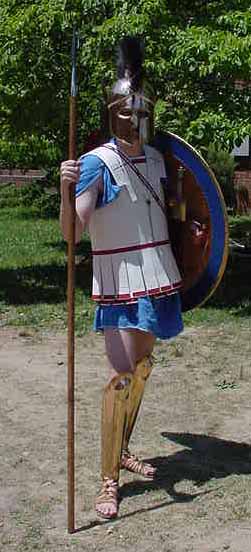
The dominant form of armor in the Persian War era is cuirass or corselet formed by a tubular body section and a yoke over the shoulders, apparently not made of metal. For years we have assumed this was called the "linothorax", made of layers of linen glued together. Peter Connolly's reconstructions were the leading force in this interpretation. I basically took Connolly at his word for my own reconstruction. I also fought against the idea of the linothorax being made of leather, mostly because of the name.
However, new
research has led to a complete revision of our conclusions.
For the latest debate, see this discussion on the Roman Army Talk board:
http://www.ancient-warfare.org/index.php?option=com_kunena&func=view&catid=19&id=231412&Itemid=40
One of the key points is made by Ruben/MeinPanzer on page 5,
from Pollux's Onomastikon:
"Spolas de thorax ek dermatos, kata tous omous ephaptomenos, hos
Xenophon ephe 'kai spolas anti thorakos'"
"The spolas is a thorax of leather, which hangs from the shoulders, so
that Xenophon says 'and the spolas instead of the thorax.'"
The bottom line is that--according to the evidence we
have--the tube-and-yoke cuirass seen in Greek artword was apparently
called a SPOLAS and made of LEATHER (either alum-tawed or a
golden vegetable-tanned). Mind you, we don't have much! But
the references in Greek literature to "linothorax" turn out to be very
few, and always seem to refer to something strange and non-Greek.
So we were all wrong!
Isn't research great? Now we can argue about just what kind of
leather to use, what color, how thick, how many layers, etc.
This obsolete page will
no longer be updated. Please see the Greek
Armor page instead.